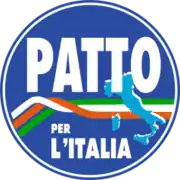Pact for Italy Patto per l'Italia | |
|---|---|
 | |
| Leader | Mariotto Segni Mino Martinazzoli |
| Founded | January 1994 |
| Dissolved | March 1995 |
| Ideology | Liberalism Christian democracy |
| Political position | Centre |
The Pact for Italy (Italian: Patto per l'Italia) was a centrist political and electoral alliance in Italy launched by Mario Segni and Mino Martinazzoli in 1994.[1][2]
History
The alliance was composed of the Italian People's Party (PPI), the main successor party to Christian Democracy, the Segni Pact,[3] the Liberal Democratic Union of Valerio Zanone and remnants of the Italian Republican Party (PRI), alongside a certain number of independent politicians coming from the Italian Socialist Party and the Italian Democratic Socialist Party.[4]
Originally Lega Nord was to also join the alliance, but Lega Nord leader Umberto Bossi decided to join Silvio Berlusconi's Pole of Freedoms instead.[5][6]
The alliance finished third place in the 1994 general election, behind the centre-right Pole of Freedoms/Pole of Good Government and the left-wing Alliance of Progressives. The alliance returned 33 seats in the Chamber of Deputies.[7]
After the election, the alliance was disbanded. The PPI suffered a split of those who wanted to join Berlusconi's centre-right coalition (breaking from the PPI and forming the United Christian Democrats of Rocco Buttiglione) and those who wanted to ally with the left-wing Democratic Party of the Left (PDS).[8] The remaining PPI joined the PDS in the centre-left coalition The Olive Tree led by Romano Prodi.[8] Segni Pact become a minor force and formed the Pact of Democrats joint electoral list with Italian Renewal and the Italian Socialists for the 1996 general election in support of The Olive Tree.[9] The Italian Republican Party and the Liberal Democratic Union joined the list Populars for Prodi, also in support for The Olive Tree.[10]
Composition
It was composed of the following political parties:
| Party | Ideology | Leader | |
|---|---|---|---|
| Italian People's Party (PPI) | Christian democracy | Mino Martinazzoli | |
| Segni Pact (PS) | Centrism | Mariotto Segni | |
| Italian Republican Party (PRI) | Liberalism | Giorgio La Malfa | |
| Liberal Democratic Union (ULD) | | Liberalism | Valerio Zanone | |
The Pact was also joined by a number of former members of the Italian Socialist Party (PSI) and the Italian Democratic Socialist Party (PSDI), now running as independents, such as Giuliano Amato[11] and Giulio Tremonti.[12]
Electoral results
| Election | Leader | Chamber of Deputies | Senate of the Republic | ||||||
|---|---|---|---|---|---|---|---|---|---|
| Votes | % | Seats | Position | Votes | % | Seats | Position | ||
| 1994 | Mario Segni | 6,019,038 | 15.63 | 4 / 630 |
3rd | 5,519,090 | 16.69 | 31 / 315 |
3rd |
References
- ↑ David Broughton (1999). Changing Party Systems in Western Europe. Continuum International Publishing Group. p. 78. ISBN 978-1-85567-328-1. Retrieved 20 August 2012.
- ↑ Leonardo Morlino (1995). "Political Parties and Democratic Consolidation in Southern Europe". In Richard Gunther; Nikiforos P. Diamandouros; Hans-Jürgen Puhle (eds.). The Politics of Democratic Consolidation: Southern Europe in Comparative Perspective. JHU Press. p. 378. ISBN 978-0-8018-4982-4.
- ↑ Guido Ortona; Stefania Ottone; Ferruccio Ponzano (2007). "A simulative assessment of the Italian electoral system". In Fabio Padovano; Roberto Ricciuti (eds.). Italian Institutional Reforms: A Public Choice Perspective: A Public Choice Perspective. Springer. p. 34. ISBN 978-0-387-72141-5.
- ↑ Stephen P. Koff (2000). Italy: From the 1st to the 2nd Republic. Routledge. p. 71. ISBN 978-1-134-64369-1.
- ↑ Galli, Giorgio (2001). I partiti politici italiani. Milan: BUR. pp. 394–395.
- ↑ Signore, Adalberto; Trocino, Alessandro (2008). Razza padana. Milan: BUR. pp. 79–82.
- ↑ Aldo di Virgilio; Steven R. Reed (2011). "Nominating Candidates Under New Rules in Italy and Japan: You Cannot Bargain with Resources You Do Not Have". In Daniela Giannetti; Bernard Grofman (eds.). A Natural Experiment on Electoral Law Reform: Evaluating the Long Run Consequences of 1990s Electoral Reform in Italy and Japan. Springer Science & Business Media. p. 83. ISBN 978-1-4419-7228-6.
- 1 2 Gino Moliterno, ed. (2000). Encyclopedia of Contemporary Italian Culture. Routledge. p. 852. ISBN 978-1-134-75877-7.
- ↑ André Krouwel (2012). Party Transformations in European Democracies. SUNY Press. p. 323. ISBN 978-1-4384-4481-9.
- ↑ Bull, Martin; Rhodes, Martin (1997). Crisis and Transition in Italian Politics. Routledge. pp. 102–103. ISBN 978-1-135-22274-1.
- ↑ "In cinque punti il programma del Patto per l'Italia". Corriere della Sera. 13 February 1994.
- ↑ "Tremonti e Martino: amici ma avversari". Corriere della Sera. 26 March 1994.